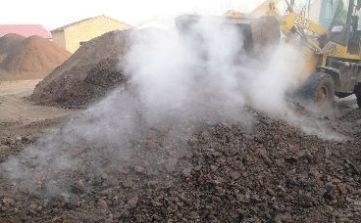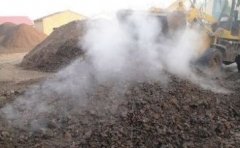What is microbial fertilizer? How to use microbial fertilizer and what are the advantages of microbial fertilizer?
What is microbial fertilizer? The most essential and remarkable feature of microbial fertilizer is that it is a living and living fertilizer. How did it come into being? Let's take a look at it.
What is microbial fertilizer
Microbial fertilizer refers to a solid or liquid preparation containing certain living microorganisms or enzymes applied to seeds, seedlings or soil, which can enhance the effectiveness of nutrition or increase nutrients in the soil and supplement the number of beneficial microorganisms in the soil. make the soil function in a good ecological environment. According to their functions, microbial fertilizers can be divided into nitrogen-fixing bacteria (including symbiotic, symbiotic and non-symbiotic nitrogen-fixing bacteria), phosphate-solubilizing bacteria (including fungi, actinomycetes and bacteria), silicolytic bacteria, mycorrhizal fungi, rhizosphere microorganisms that promote crop growth, decomposing bacteria, iron-producing bacteria, organic polymer producing bacteria, compound microbial fertilizers, microbial fertilizers for composting, etc.

Second, the function of microbial fertilizer
The functions of microbial fertilizer are mainly as follows:
(1) nitrogen fixation: nitrogen-fixing rhizobia, including symbiotic, symbiotic and non-symbiotic nitrogen-fixing rhizobia, can fix nitrogen in the air to ammonia and transform it into nitrogen compounds that can be used by peanuts, which can directly increase the source of nitrogen in the soil. and can replace or reduce the application of chemical nitrogen fertilizer.
(2) dissolution: there are many combined nutrient elements in the soil that can not be used by peanuts, such as phosphorus, calcium, iron and so on, which can only be used by dissolved bacteria in the root zone. the bacteria that dissolve the combined nutrient elements can be used to provide nutrition reuse of peanuts and can replace or reduce the application of chemical fertilizers, such as mycorrhizal fungi.
(3) the effect of improving root nutrition absorption and growth: microbial fertilizer has bacteria that can promote root nutrition absorption and growth, and increase root absorption capacity and surface area, which can reduce the application of chemical fertilizer and improve the efficiency of nutrient supply in soil. such as mycorrhizal fungi.
III. Methods of using microbial fertilizers
According to the type of seed mixer, the use of microbial fertilizer can be divided into two types: nitrogen-fixing rhizobium liquid agent and mycorrhizal solidification agent, which are described as follows:
The main results are as follows: (1) the method of seed dressing with nitrogen-fixing rhizobium liquid: invade or spray peanut seeds with 5-fold diluent to make the seeds come into contact with the liquid, wait for air-drying and then sow mechanically.
(2) the method of seed dressing with mycorrhizal mycorrhizal solidification agent: peanut seeds were directly added with adhesive and a small amount of water, and then the seeds were coated with solidification agent and sowed mechanically.
Discussion on microbial Fertilizer
Does "microbial fertilizer" really have magical effects like propaganda? Wu Sanhe, a professor in the department of agrochemistry at National Taiwan University, says that no matter in terms of accelerating the decomposition of compost or promoting plant growth, he believes that this kind of microbial fertilizer or reagent is not very useful, and people still use qualified organic compost to add nutrients to plants.
Wu Sanhe said that Japan has the largest number of such microbial products, but even Japan itself is exploring whether it has special effects. In general, plants grow well after using this kind of microbial fertilizer, which may be attributed to good care. The composting production time must be more than six months, generally rapid decomposition of fertilizer, may be due to lack of time, resulting in soil incomplete maturity, still acidic, but easy to cause plant death.
Zhao Zhenqing, Professor of the Department of soil and Environmental Sciences of Zhongxing University, pointed out that such artificially cultured microbial agents are usually the most suitable for the growth of the organism in the culture environment, but when they are inoculated into the soil, they will face an environment full of lethal risks, such as abandoning greenhouse flowers in the wilderness, and these bacteria will gradually die at room temperature and drop below the concentration that plays a role. He has doubts about the function of these commercially available microbial fertilizers or reagents.
Zhao Zhenqing said that commodities on the market are often marked unclearly, usually only contain a number of nitrogen-fixing bacteria, phosphorus-solubilizing bacteria, composting decomposing bacteria, and what is more, they only write how many hundreds of millions of microorganisms per gram of preparation. In fact, every handful of soil has more than 10 billion bacteria per gram of soil, and although there are many microorganisms beneficial to crop growth, they may also contain harmful bacteria, which may cause a lot of sequelae if they cannot be clearly stated. Everyone should be very careful when using it.
A Taiwan Sugar researcher said that although some farms had positive views on this kind of microbial fertilizer, Taiwan Sugar had done research and found that it had no obvious effect on promoting the rapid decomposition of compost, and the soil environment was different in different places. microorganisms that can act on foreign crops and land may not necessarily act on Taiwan, and even the land environment in Taiwan is different. The application of this kind of microorganisms must be adapted to local conditions in order to function.
- Prev

How to fertilize the soil: the main source of crop nutrients and the key points of land fertilization management
Fertilizer management: to achieve the goal of sustainable agricultural production, to make nature circulate continuously and live forever. This is the ecological balance we need to achieve. The main significance of the fertilizer management of sustainable agriculture is to supply crop support by using natural materials that do not consume energy.
- Next

What is microbial fertilizer? How to use microbial fertilizer and what are the advantages of microbial fertilizer?
What is microbial fertilizer? The most essential and remarkable feature of microbial fertilizer is that it is a living and living fertilizer. How did it come into being? Let's take a look at it. I. what is microbial fertilizer? microbial fertilizer means that it contains
Related
- Fuxing push coffee new agricultural production and marketing class: lack of small-scale processing plants
- Jujube rice field leisure farm deep ploughing Yilan for five years to create a space for organic food and play
- Nongyu Farm-A trial of organic papaya for brave women with advanced technology
- Four points for attention in the prevention and control of diseases and insect pests of edible fungi
- How to add nutrient solution to Edible Fungi
- Is there any good way to control edible fungus mites?
- Open Inoculation Technology of Edible Fungi
- Is there any clever way to use fertilizer for edible fungus in winter?
- What agents are used to kill the pathogens of edible fungi in the mushroom shed?
- Rapid drying of Edible Fungi

